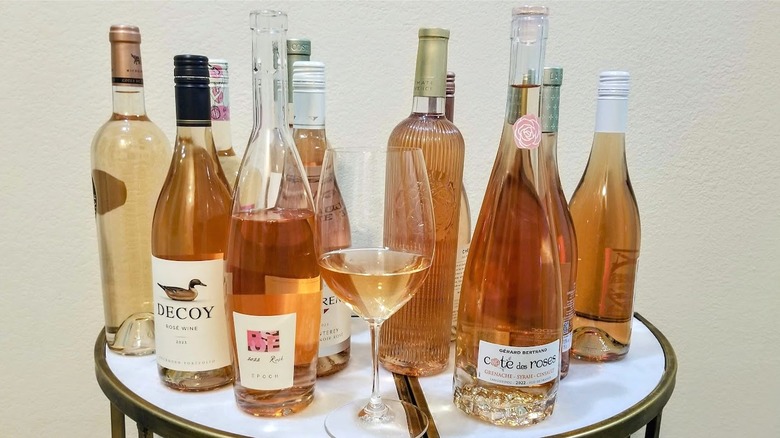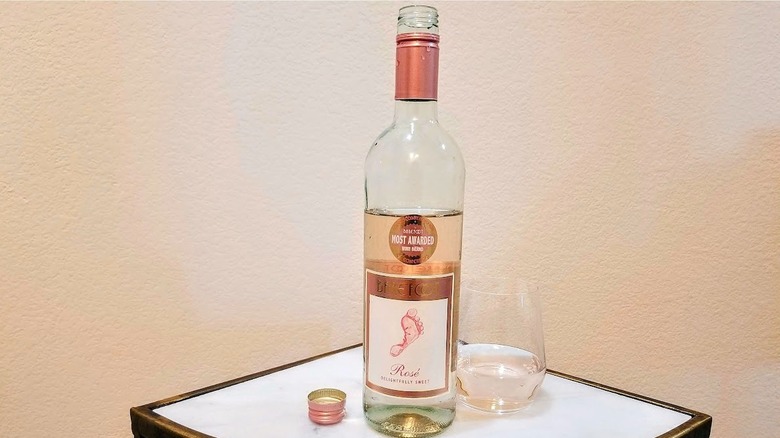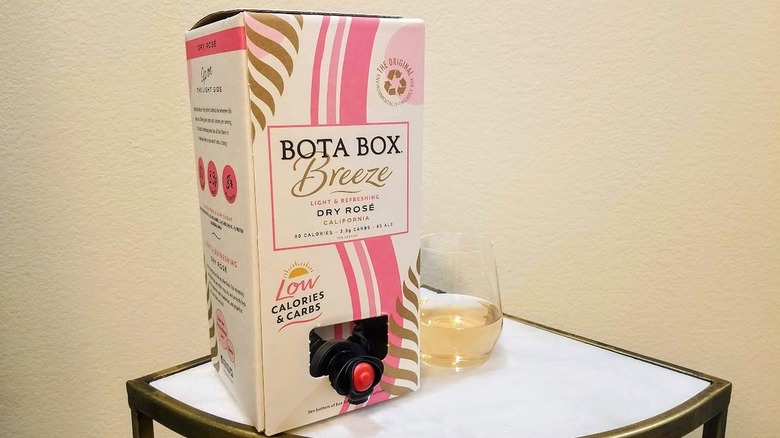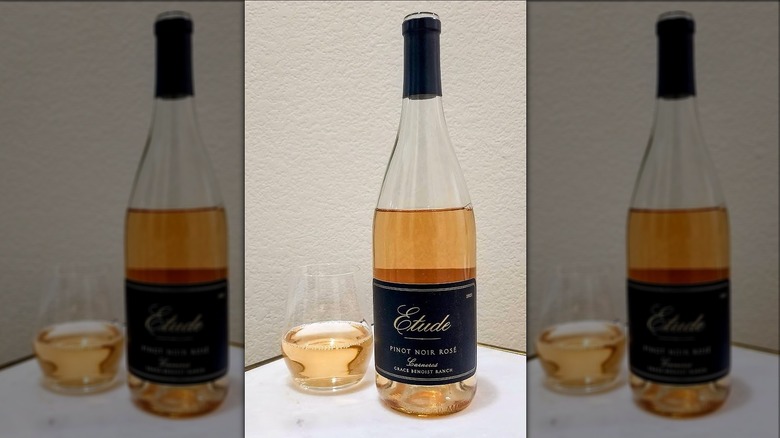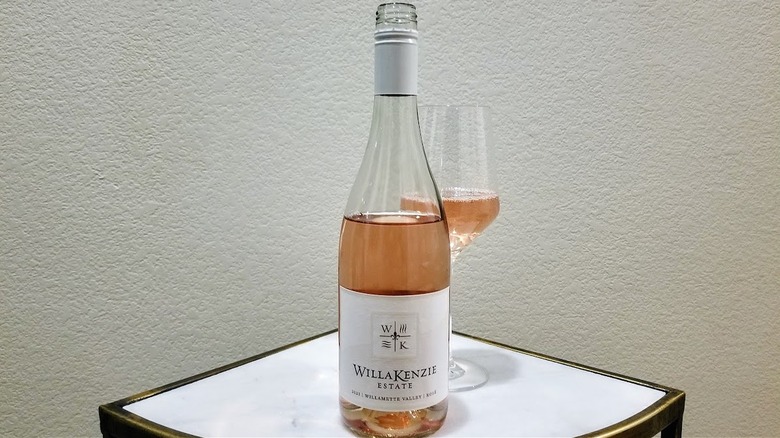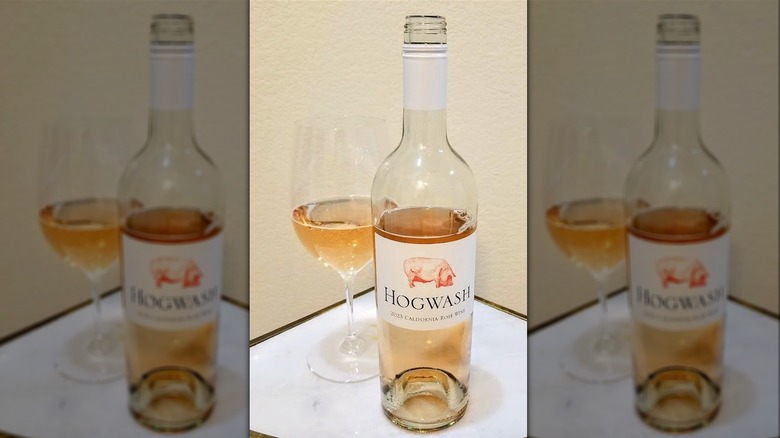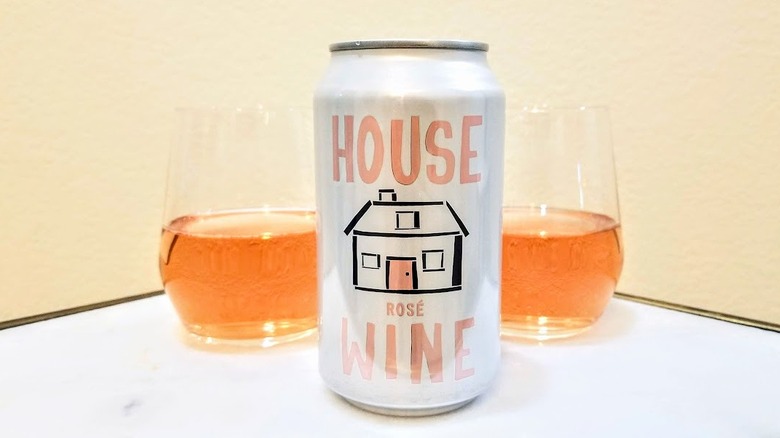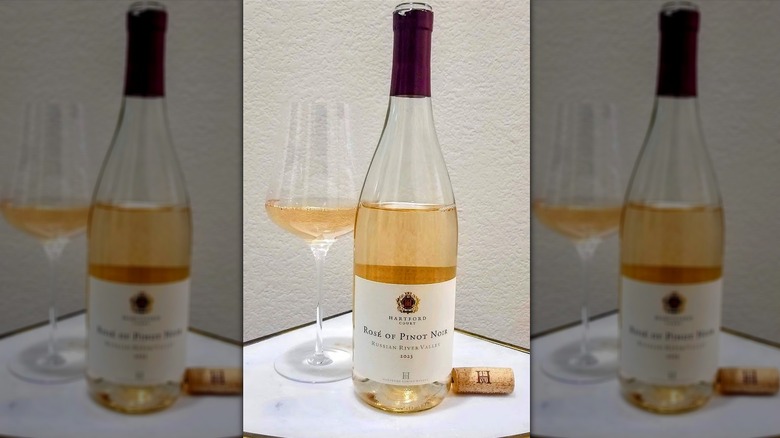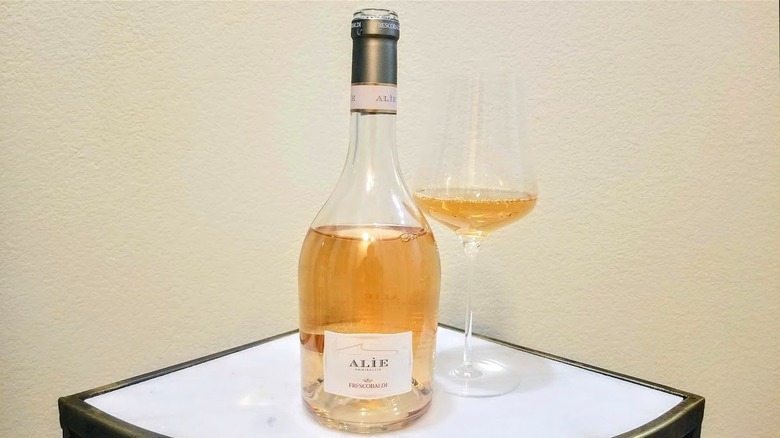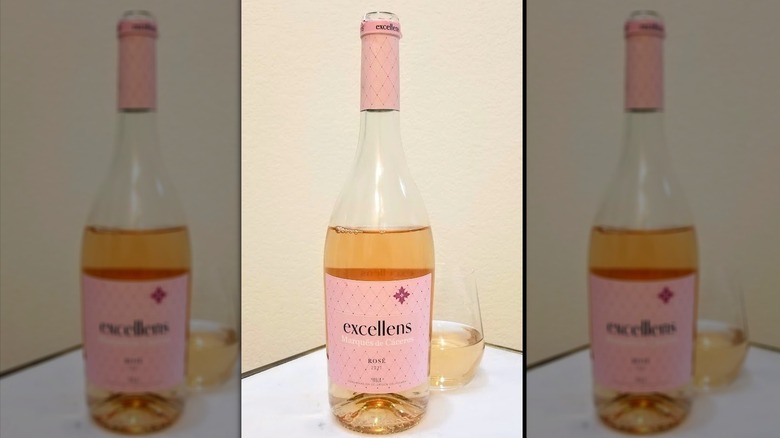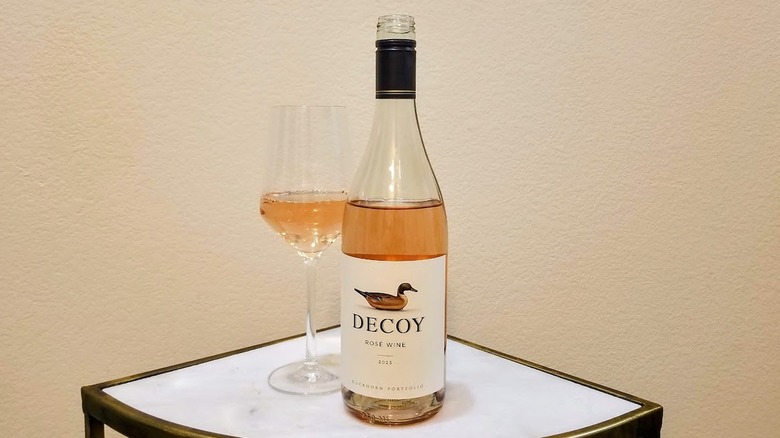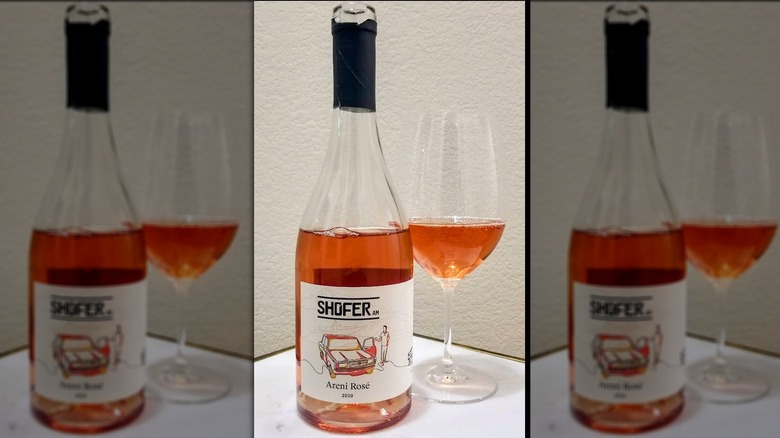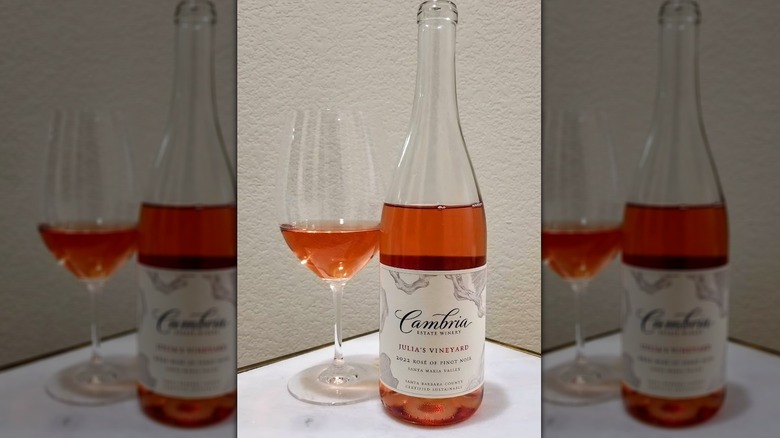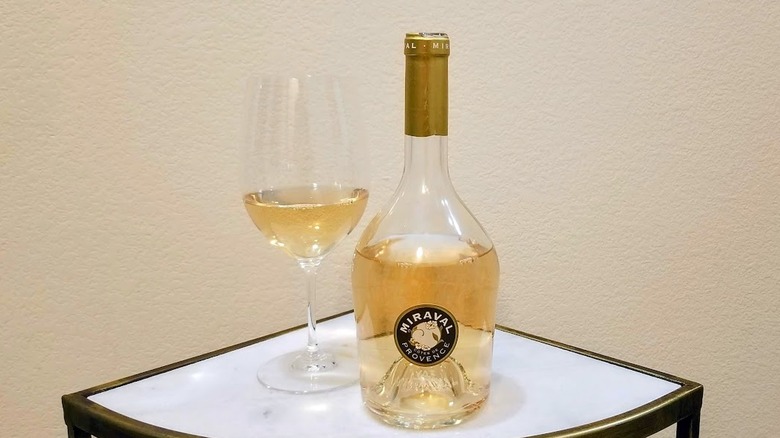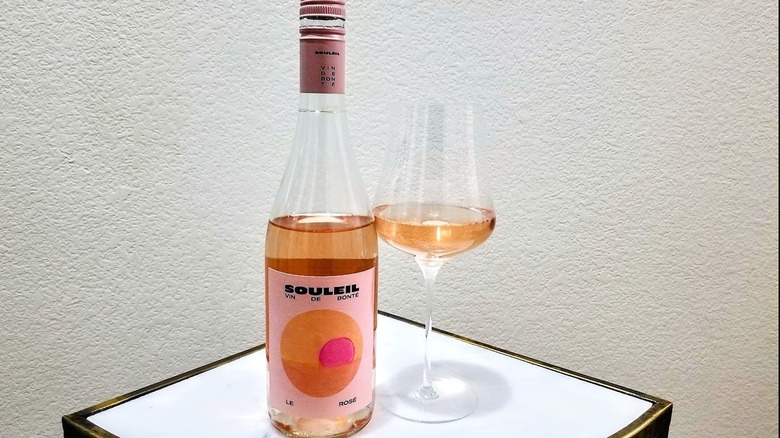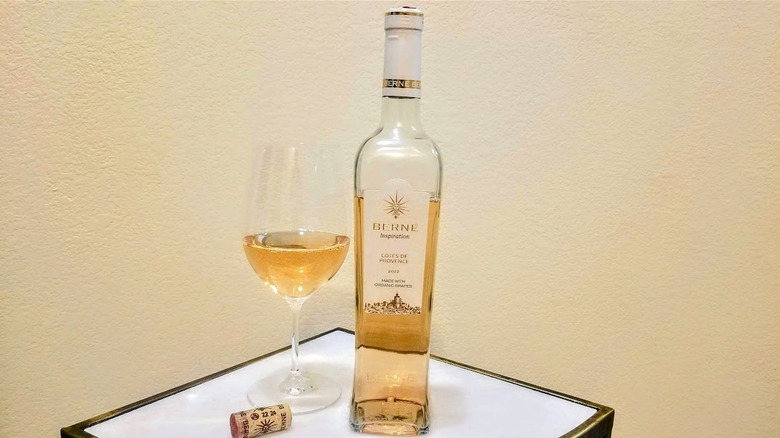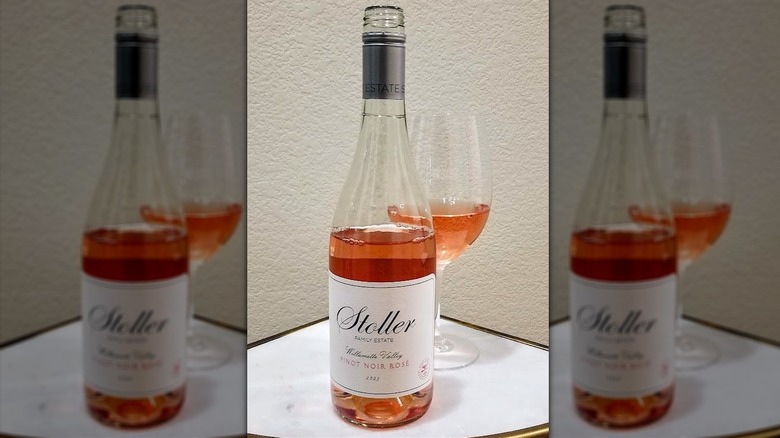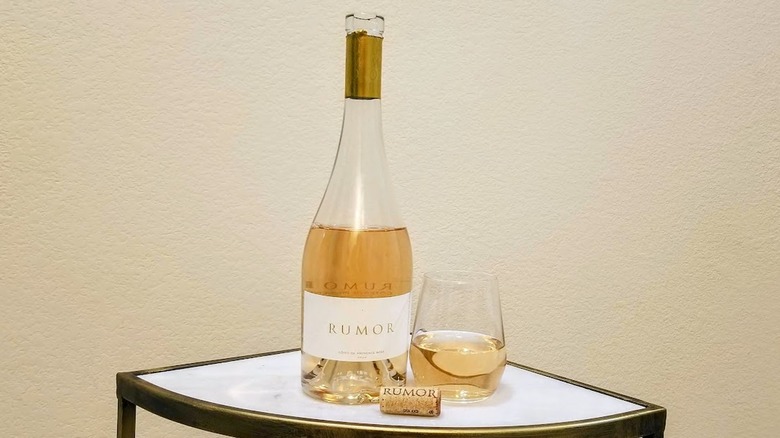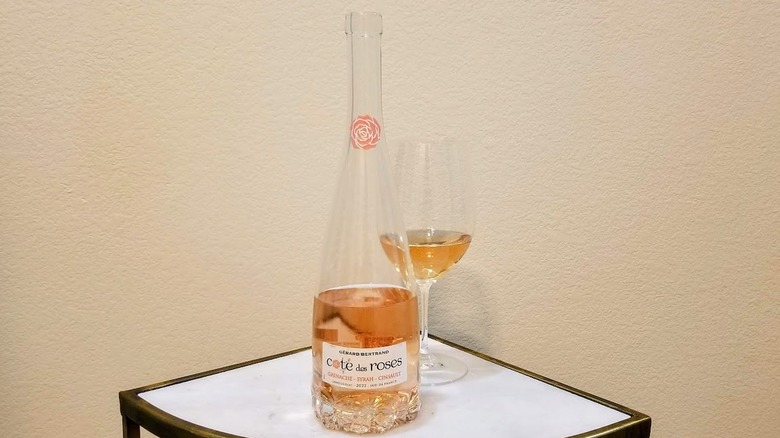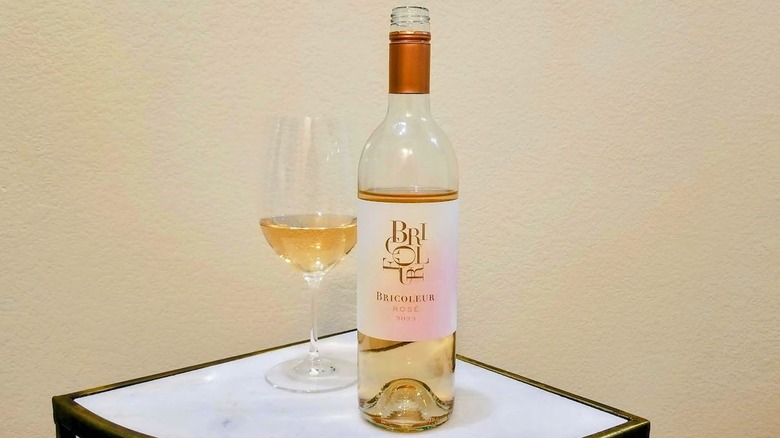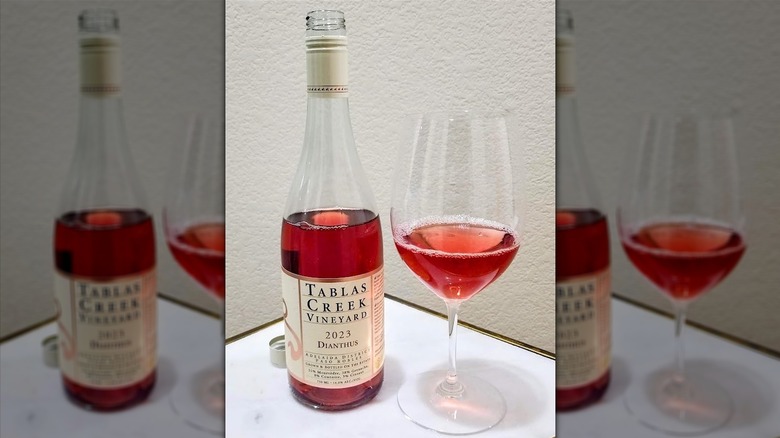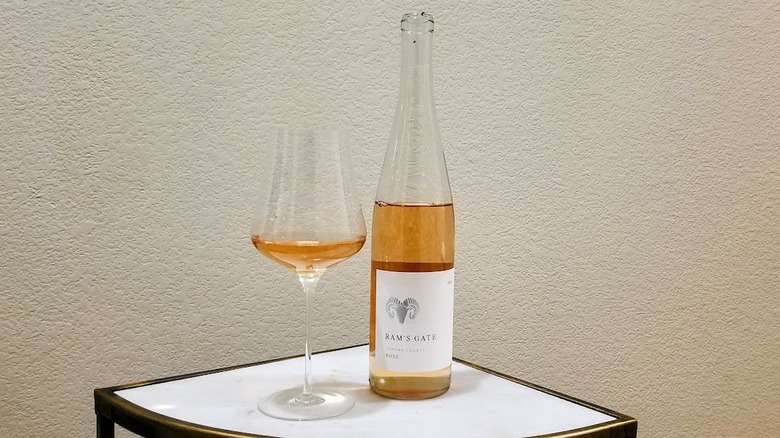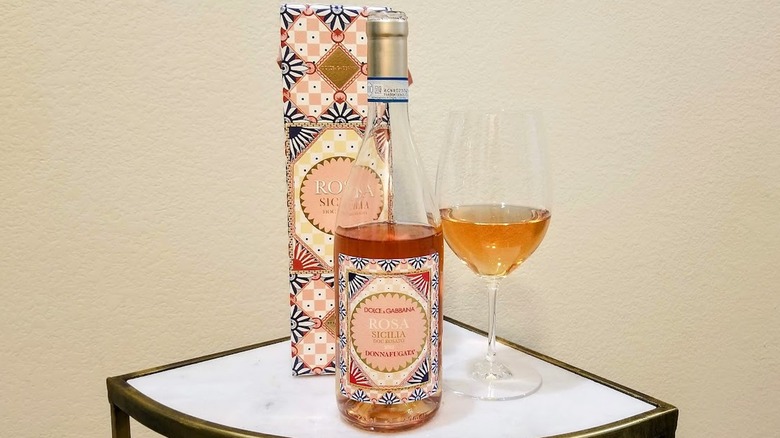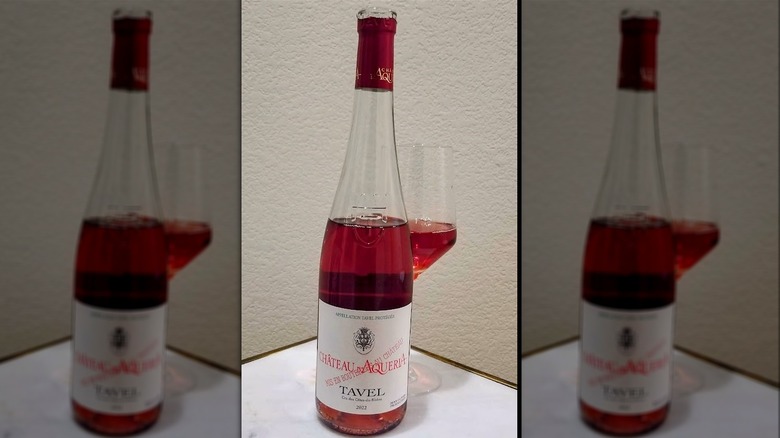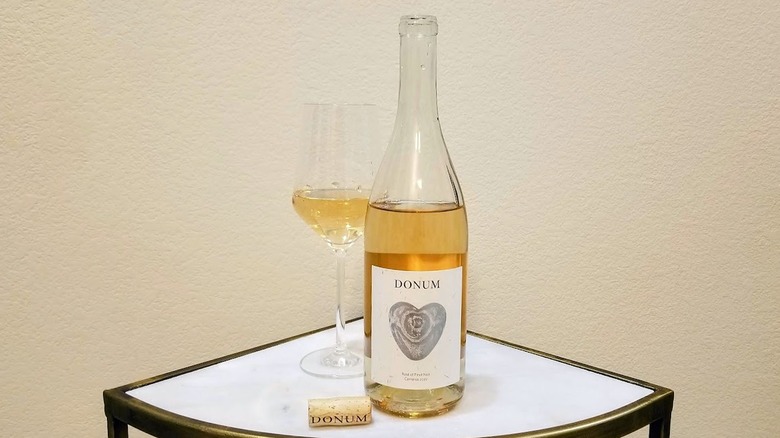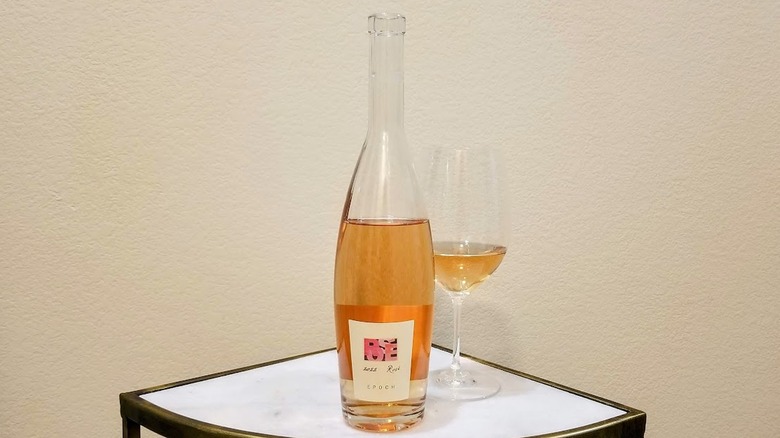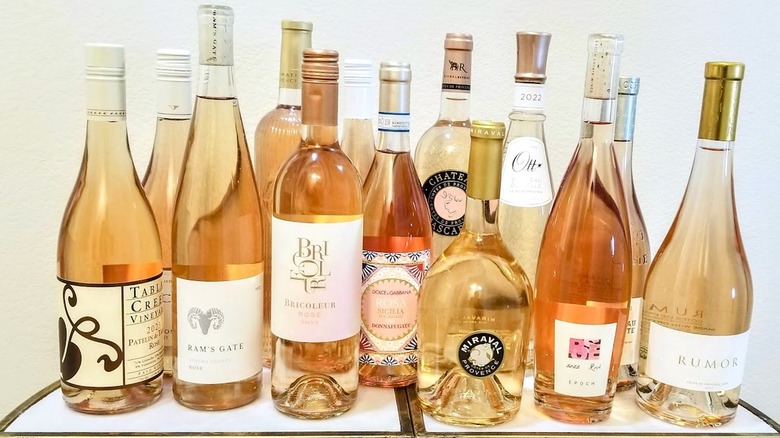25 Rosé Wine Brands, Ranked Worst To Best
Up until a few decades ago, no one was drinking pink wine. The love affair with sweet white zinfandel in the '80s and '90s turned sour around the turn of the millennium. But since then, dry rosé wine, made from grape varieties besides just zinfandel, has become one of America's favorite summer drinks.
But don't think rosé is just for sipping on balmy days. This wine is a year-round delight; it perfectly complements holiday feasts, including everything served on Thanksgiving to an array of unconventional foods, like lamb burgers or lobster rolls.
Wineries today have recognized rosé's surge in popularity. Many have added it to their lineup or increased the number of rosés selections already offered. Several rosé producers have also embraced sustainable, organic, and biodynamic winemaking methods to better showcase the terroir.
Considering the plethora of rosé options, it's easy to get lost in the sea of pink. As a certified sommelier, I've taken the guesswork out of the equation. I've curated a list and tasted some of the most popular rosé wines before ranking them on factors like taste, availability, popularity, and provenance.
Some recommendations are based on first-hand impressions of promotional materials and products provided by the manufacturer/distributor/etc.
25. Barefoot
Barefoot is a favorite of many wine lovers, some of whom selected it as the best affordable wine brand. The producer offers a variety of rosé options, including pink moscato and sweet rosé, each with a low alcohol by volume (ABV). The Delightfully Sweet rosé I sampled has 10% ABV.
The lower alcohol content indicates that there is likely a higher amount of residual sugar. This wine is great for sweet wine lovers. However, the sweetness masks the fruit's natural flavors. At the same time, the wine lacks the acidity needed to cut through the sugar, which places the brand last on my list.
24. Bota Box
Bota Box's boxed wines are perfect if you're looking for an affordable, large-format wine option that remains fresh for up to 30 days. The Forest Stewardship Council-certified cardboard boxes have a low carbon footprint, especially compared to traditional glass wine bottles.
The brand offers various rosé wine options, including a dry rosé with 11.5% ABV and the Breeze rosé with 8% ABV and a low 80 calories per 5-ounce serving. The non-vintage California rosés have dry notes that weigh down the palate and mask the natural flavor of the natural fruit — which earns the brand a low ranking.
23. Etude
Etude Winery's Grace Benoist Ranch rosé intends to highlight the cool-climate growing conditions of the Carneros region of Northern California. The wine's pinot noir fruit was specifically chosen from the estate vineyard for rosé production to showcase its freshness and fruity aromas.
The small production rosé of pinot noir, with an ABV of 12.2%, has inviting strawberry, peach, and red apple aromas. However, I found the flavors far too sweet and without the necessary balance of acidity. I prefer something drier, which pushes Etude down on the list. Still, if you enjoy this style, you may enjoy the wine.
22. WillaKenzie Estate
Oregon's Willamette Valley is an international leader in pinot noir production. Its WillaKenzie Estate, named after the area's loamy soils, has showcased the variety since its inception.
WillaKenzie's Willamette Valley rosé is whole cluster pressed and extracts minimal color, creating a delicate blush wine with flavors of bitter orange peel, ripe cherry, and peach. Though the front palate exudes ripe fruit and fresh acidity, the 13.5% ABV wine finishes with a tart, unbalanced bitterness, earning it a lower ranking.
21. Hogwash
Hogwash's California appellation rosé begins with a base of grenache. It has a fruit-forward flavor with a lower alcohol content, around 12% ABV. The dry wine layers wild strawberry, citrus, and golden peach notes. It is an uncomplicated selection that pairs well with spicy dishes, like Asian-inspired coleslaw. However, it lacks the structure and well-rounded character I found in higher-ranking wines, which pushed it down on the list.
19. House Wine
I love the convenient two-glass cans of House Wine rosé. Although it can be purchased in 3-liter boxes, its 12% alcohol aluminum cans are one of the best canned rosé options. They're the perfect size to pop in your cooler for beach or poolside sipping.
The approachable selection offers juicy, thirst-quenching wild berry and watermelon flavors. House Wine is not overly complex or highly structured — but I don't expect a canned wine to be. Instead, it is an easy-to-drink option that is not the finest wine, but certainly not the worst.
19. Hartford Family Winery
Hartford Family Winery's rosé has a delicate style with a subdued flavor profile, especially compared to some of the other pinot noir rosé wines in the ranking. It boasts a blushing salmon color and soft aromas of white peach and melon.
The 13.5% ABV wine offers a fresh and clean fruitiness on the palate, with subtle stone fruit and strawberry notes. The light nature of the rosé makes it a great option if you are mixing drinks with wine, like in a charred peach sangria. However, I prefer a wine with more distinctiveness for sipping solo, which keeps this brand from climbing any higher on my list.
18. Frescobaldi
Frescobaldi Alìe rosé is an aromatic, Old World-style wine from the seaside vineyards of Tenuta Ammiraglia in the heart of Tuscany's Maremma region. Alìe shines as an easy-to-enjoy, 12% ABV rosé of syrah, which lends blue fruit notes, and vermentino, which adds citrus, dried herbs, and saline flavors. This wine would pair wonderfully with produce, like a grilled summer vegetable salad.
Though the opening of the wine was strong, the finish of Alìe was short. Its flavor faded rather quickly, especially compared to other higher-ranking wines.
17. Marqués de Cáceres
For over 50 years, Marqués de Cáceres has been a leader in producing quality Spanish wines. The brand's Excellens rioja blends tempranillo from Rioja Alavesa and cenicero and garnacha from Rioja Alta's high-elevation vineyards.
The winery's efforts to blend hand-harvested fruit from throughout the Rioja region allow the Spanish terroir to shine through. This is an earthy wine with green peppercorn, wild herb, and red fruit notes. I appreciate the fruit and savoriness of the dry 14% ABV wine. However, there is a rusticity in the wine that was not fully integrated, which kept it from ascending up the list.
16. Decoy
Decoy's rosé uses fruit grown specifically to produce rosé from vineyards in central and northern California. This allows the winery to control the fruit's harvest time to ensure the selected Provençal varietal grapes have full ripeness and crisp freshness.
The bright and refreshing 13.9% ABV wine is easy to drink, with notes of luscious red berries, melon, and dried herbs. The rosé is tasty, which earned it a well-deserved spot in the middle of the pack. Though enjoyable straight from the glass, I found it also adds a pop of flavor to a strawberry rosé spritzer.
15. Shofer
Armenia may not be the place you think of when you think of wine production. However, it is one of the oldest wine-producing countries in the world, with a history dating back to 4100 B.C. Today's producers showcase native varieties and make approachable wines with exceptional character, like Shofer's Areni rosé.
Areni is one of Armenia's signature varieties. Its style resembles pinot noir; it boasts acidity, black fruit flavors, and lovely texture. When crafted into a rosé, as in Shofer's well-placed selection, the result is a wine with fragrant aromas of herbs and spices and a fruit-forward palate that pairs well with pomegranate-glazed salmon.
14. Cambria Estate
The Julia's Vineyard rosé from Cambria Estate Winery is a lovely example of a Central California rosé. The vineyard's soils include a mix of limestone, shale, and sandstone, which lend a mineral note to the wine. Meanwhile, Santa Barbara sunshine ensures the fruit's even ripening and makes for a full-bodied flavor.
The hand-selected pinot noir grapes are whole cluster pressed and fermented in stainless steel, ensuring the grape's freshness is at the forefront. While not as complete as the rosé at the top of they list, the 13.1% ABV wine's clean, fruity flavors earn it a midpoint spot in the ranking.
13. Château Miraval
Château Miraval crafts a desirable selection of Côtes de Provence rosé wines, including its signature Miraval, Studio by Miraval, and luxurious Muse de Miraval. Miraval's wines reflect the terroir with Provençal style, enhanced by the region's limestone and clay soils and garrigue of wild thyme, sagebrush, and lavender.
The vineyard's location near the Mediterranean Sea brings salty breezes through the vines, which imparts mouth-watering saline flavors into the wine. Miraval's rosé has a weighty texture with concentrated red fruit and herbal flavors. It delivers a well-balanced 13% ABV wine and earns itself a comfortable spot on my list.
12. Souleil Vin de Bonté
There are many reasons to like Souleil Vin de Bonté rosé. The Vin de France appellation rosé is sourced from organically-grown grapes in Mediterranean vineyards. A portion of the financial proceeds from the sustainably produced, vegan wine goes towards cleaning the oceans.
The 12.5% ABV wine opens with ripe mandarin, passionfruit, and herbs de Provence flavors, with a mineral note that lingers throughout. The lovely, expressive rosé balances acidity and lush fruit-forward flavors, which is why I placed it in the middle of the rosés.
11. Château de Berne
Château de Berne crafts a range of rosé options sourced from the chalky beds of its 330-acre terroir. The winery's philosophy embraces environmentally friendly, organic farming that is good for the Earth while producing authentic wines, like its Inspiration Rosé. It also offers Emotion and Romance rosé to U.S. buyers.
The 12.5% ABV wine immediately awakens the taste buds with a bright, crisp acidity on the front palate. The freshness softens as it reaches the back palate. Still, the grenache-based, red berry, lychee, and stone fruit-filled wine is well-balanced and highly drinkable, giving the brand a solid standing in this ranking.
10. Stoller Family Estate
Stoller Family Estate is a B Corp Certified winery and the first Leadership in Energy and Environmental Design (LEED) Gold Certified winery worldwide. It's dedicated to reducing its carbon footprint and offering consumer transparency, which are two principles I'll toast to.
Stoller Family Estate crafts a well-rounded 12.5% ABV pinot noir rosé wine with an eye-catching pink hue. It displays wild strawberry, watermelon, tangerine, and ruby red grapefruit flavors, showcasing a lovely example of rosé wine from the Willamette region.
Stoller's environmental and social commitment, along with the delicious taste of the rosé, pushes this wine up to the top. I suggest pairing it with roasted grapefruit chicken thighs to highlight the wine's citrus notes.
9. Rumor
Rumor rosé, sourced from organically grown grapes in Côtes de Provence, symbolizes accessible luxury. The dry, vegan, salmon-colored wine is produced with a low-intervention approach, which allows the natural characteristics of the southern French region to shine through.
It was easy to detect mineral flavors from the rocky clay soils, a fragrant earthiness, and ripe red fruit flavors from the blend of Rhone Valley grape varieties. The resulting 13% ABV wine perfectly balances fruit-forward flavors with a savory appeal.
8. Gérard Bertrand
Gérard Bertrand's biodynamically farmed vineyards span hillside estates in the foothills of the Pyrenees Mountains to Mediterranean coastal estates within Southern France's Languedoc-Roussillon region. The producer creates a range of expressive rosé wine from these vineyards, including the widely distributed Cotes du Roses rosé and the high-end, barrel-fermented Château la Sauvageonne.
The Cotes du Roses blends grenache, syrah, and cinsault to create a coral-hued, 13% alcohol wine bursting with crunchy red fruits and a distinct minerality from the region's limestone and schist soils. Gérard Bertrand's wines have a refreshing palate, food-friendly flavor, and terroir-driven authenticity, placing them high on my list.
7. Bricoleur
Bricoleur Vineyards delivers everything I want in a dry rosé table wine. It begins with inviting aromas of wild herbs, lavender, and red berries, which entice you to taste it. The palate delivers plush red fruits, ripe stone fruit, and a crushed stone note with zesty acidity that keeps you going back for more.
This 100% Grenache rosé is grown using sustainable farming practices and produced in the winery's solar-powered facility. With a 13.7% ABV, the Sonoma County wine is juicy, lively, and highly refreshing, comfortably placing this small-production beauty among my top picks.
6. Tablas Creek
Tablas Creek, located in California's Paso Robles region, is an international leader in biodynamic production. It received organic certification in 2003 and became the world's first Regenerative Certified Winery estate in 2020. Its growing practices focus on the soil's health and authenticity-driven wines, which is reflected in selections like its Dianthus rosé.
The rosé is complex and well-structured, blending 51% mourvèdre with grenache, counoise, and cinsault. Like the rosé wines from Tavel, France, food-friendly Dianthus has a deep pink hue, golden peach, apple, and tangerine flavors, and a punchy, fresh acidity. The 14% ABV wine's profile, gastronomic qualities, and the winery's environmentally friendly farming practices rank Tablas Creek high.
5. Ram's Gate
Ram's Gate Winery, located in the Carneros region of Sonoma County, showcases the region's cool growing conditions in its wines. The location ensures elegant wines with refined character, like Ram's Gate's estate pinot noir and chardonnay or its aromatic rosé, which features full-bodied mourvèdre and medium-bodied pinot noir.
The small-production, 14% ABV wine is aged for six months in neutral oak to give the flavors time to meld. The result is a textured, succulent rosé wine that opens crisp and ends with a velvety richness, placing it among the best rosés I sampled. The rosé opens with fragrant aromas of orange zest, honeysuckle, and red fruits that lead to ripe melon and stone fruit.
4. Donnafugata
Donnafugata's three rosé expressions highlight the mineral-rich volcanic soils of Mount Etna and the expressive character of native Sicilian varieties. For the Donnafugata Rosa, the winery teamed with the iconic fashion brand Dolce & Gabbana to create a wine of distinction that displays a mutual affection for the Italian island.
This expression blends the historic nocera variety, a grape grown during Roman times with luscious red fruit flavors, and native nerello mascalese, which adds adding aromatic floral notes. The combination creates a 12.5% ABV wine with a delicate color, silky texture, and appealing character. The flavorful wine is displayed elegantly with a Dolce & Gabbana-designed label and box reminiscent of Sicilian tiles. This wine honors its heritage both in flavor and design.
3. Château d' Aqueria
I love it when a wine's aroma has the strength and complexity to wash over me, as I found was the case with this gorgeous Tavel rosé selection from Château d' Aqueria. I was greeted by aromas of wild cherry and framboise with concentrated red fruit flavors of cherry and pomegranate with savory herbs. The richness and balance of the wine make it a highly gastronomic selection.
As typical of Tavel rosé, which tends to be darker in color than those of the nearby Provence, the wine has an incredible depth of flavor with rich structure and concentration. This earns it a coveted spot in my ranking. The 14% ABV wine has a weight that can easily pair with heavier foods, like a balsamic-glazed pork tenderloin.
2. Donum
Donum Estate boasts organically and regeneratively farmed vineyards. It focuses on developmental practices and embodies the idea that healthy vines make great wine. Like the large-scale sculptures dotted throughout the estate vineyards, the wine displays elegant artistry. Though the wine has a graceful refinement, it does not lack in character, which is a testament to the estate's commitment to quality.
Donum's rosé showcases fruit from a pinot noir vineyard block grown explicitly for rosé. The fruit ferments in neutral French oak with native yeast and ages on the lees (leftover yeast strains from fermentation) for three months. The fermentation method and brief aging add texture to the rosé and enhance its complexity.
The wine's natural acidity lifts the palate, with juicy cherry and fresh strawberry flavors that finish with a hint of saline. It's a beautifully textured and fresh 12% ABV wine sourced from a winery dedicated to reversing climate change by improving soil health. What more could you want from a high-ranking rosé?
1. Epoch Estate
Epoch Estate crafts one of America's best expressions of rosé, which earns it the top spot on my list. The engaging wine comes from Epoch's three historical estate vineyards within Paso Robles. Each boasts a mix of soil types, elevations, and microclimates, which creates terroir-driven rosé wine. The shale, limestone, and sandstone soils give the wine an earthy, completely satisfying mineral intensity.
Epoch uses a blend of sun-loving mourvèdre, juicy grenache, and spicy syrah to create a harmonious balance of juicy citrus, red berries, and rhubarb notes with herbal undertones of mint and lavender. The wine undergoes four months of sur lie aging, which texture to the drink's palate while enhancing its flavor.
The 13.9% ABV wine shows mouth-watering acidity and entices sensory appeal with sip after sip. The freshness melds with the bold, well-integrated fruit that is ever-present from the front palate to the back, ending with a long, well-balanced finish.
Methodology
To create this ranking, I pulled from a selection of wines available nationwide as well as unique, smaller-production selections that stand apart from the rest. I then tested and ranked each based on factors including the wine's provenance, production style, balance, complexity, and overall flavor.
As a trained sommelier and certified wine specialist, I have spent the past 20 years as a wine and spirits reviewer, writer, and judge, and have tasted wines from across the country and around the world.
